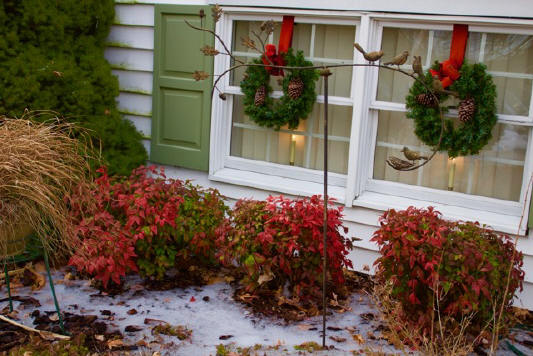Many gardeners expect nothing of their gardens in the wintertime. It is true that when the temperatures dip below freezing, flowers are extremely rare, but with a little preplanning, your gardens can still be colorful and attractive all year.
Neatness Counts
Start with the part of the garden that is most visible to you during the winter. Likely, it’s your front door entrance, or what you see when you pull into the driveway. Begin by making sure that this area is clean and neat, and that any finishes are in good condition. Remove the remnants of last summer’s now dead potted annuals. Get rid of the old Halloween decorations and fall pumpkins. Make sure trash cans are out of sight.
Create Winter Arrangements
Use your best looking container(s). It can’t be terra cotta, but if it is glazed pottery, just fill it with stone, sand or packing peanuts — anything but soil that will expand when it freezes and may break the pot. Now fill the container with evergreen cuttings, Holly berries, red twig dogwood stems, or whatever you can find. You may be surprised how easy and attractive this is, and it will look good until February.

Take Advantage of Conifers
Conifers (trees that get pinecones) are the backbone of your garden. They stay green and attractive all year long, and they protect songbirds from predators and bad weather.
Conifers can be pyramidal, rounded, or low, spreading ground covers. Depending on the purpose you have in mind, there are conifers available to fit just about any requirement. Use them for a nice dense, back drop for your garden, or intersperse them throughout the landscape. Besides green, conifers also come in shades of yellow and blue. A combination of different sizes, shapes, colors and textures can result in a very attractive and low-maintenance planting. If you have an idea of mature size and shape specifics that you need, any good nursery will guide you
toward some good selections.
More Plants with Winter Color
Conifers are not the only evergreens that are available. There is a nice selection of evergreen shrubs that do not lose their leaves in the winter. Nandina ‘Firepower’ ( Nandina domestica 'Fire Power’) is a small shrub that is great for under low windows because it never gets taller than about two feet. Its leaves are a pale green all summer, then, in the fall, they turn bright red. Those leaves remain red all winter. This shrub is not invasive as many Nandinas can be.
Boxwood is an evergreen shrub that has been popular since Colonial days. Some people do not like their distinctive odor which can be rather strong, nor are they interested in the constant pruning some boxwoods require. You can find nice boxwoods that have no odor, and, at the same time, require little or no pruning. Grace Hendricks Phillips ( Buxus microphylla 'Grace Hendricks Phillips’), has a small rounded shape that never needs pruning and makes a round two foot ball in a shady area. ‘Morris Midget’ (Buxus microphylla var. japonica 'Morris Midget’) is another
well-shaped boxwood that constantly maintains its round shape with no help from you. It is slightly larger than ‘Grace’ and likes the sun. Neither shrub has an odor.
If you have a nice wind-protected area, Otto Luyken Cherry Laurel (Prunus laurocerasus 'Otto Luyken’) is a very attractive shrub that tops out at about five feet tall and wide. It holds its green leaves all year, and produces white bottlebrush flowers in the spring.
Plants with Interesting Shapes, Textures, and Bark
Red Twig Dogwood (Cornus sericea ‘Cardinal’) is a lovely native shrub that loses its leaves, but its stems turn bright red in the winter. Winterberry holly (Ilex verticillata) loses its leaves, but produces bright red berries that catch your eye all winter until the birds eat them up. Pussy willows (Salix discolor) have bare stems in the winter, but their catkins are a welcome and lovely harbinger of spring in early March, offering some of the earliest pollination opportunities for many insects.
White birch trees (Betula populifolia), are lovely trees, but they struggle in our area. River Birch, (Betula nigra) is a beautiful native tree with very similar light-colored peeling bark in the winter. It grows well in Pennsylvania and provides year-round beauty, especially in damp areas.
I hope you are getting the idea that it is really not too difficult to have a landscape that is attractive all year. All it takes is some careful planning and thought before you buy. It also requires some fall clean-up of your gardens.
There are two schools of thought regarding cutting back perennials. One says leave everything stand to provide food and shelter for wildlife, the other says cut everything down so it looks neat. My compromise is to keep my larger backyard as a wildlife habitat, and to design my front yard as a welcoming sight for human visitors. Out front is where I have many of the plants I have discussed here while adding the very early flowering bulbs. Some of my favorites are snowbells (Galanthus spp.) that bloom in January, little blue crocuses that appear in February, and,
especially, the beautiful blue windflowers (Japanese Anemones) that attract oohs and aahs throughout the entire months of March and April. Many of these also attract pollinators. This is also where I keep up some garden art that can withstand the cold, and include winter arrangements in containers.
Read other winter related gardening articles